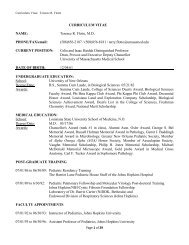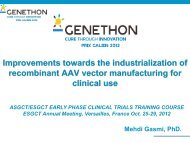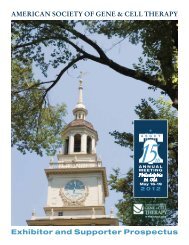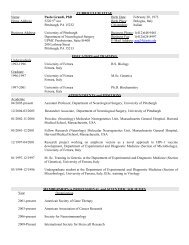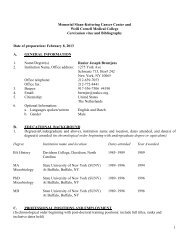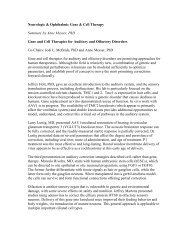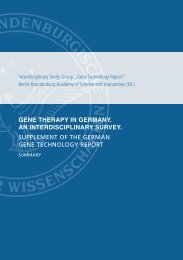Final Program - American Society of Gene & Cell Therapy
Final Program - American Society of Gene & Cell Therapy
Final Program - American Society of Gene & Cell Therapy
Create successful ePaper yourself
Turn your PDF publications into a flip-book with our unique Google optimized e-Paper software.
<strong>Program</strong> Schedule, Thursday, May 16, 2013<br />
Scientific Symposium 215<br />
10:30 am - 12:30 pm<br />
ROOM: BALLROOM A<br />
The GTRP: Perspectives <strong>of</strong> an Investigator and the <strong>Program</strong> Cores<br />
CO-CHAIRS: Cheryl L. McDonald, MD and Sonia I. Skarlatos, PhD<br />
SPEAKERS<br />
Thursday, May 16, 2013<br />
Daniel Rader, MD<br />
How the GTRP Facilitates Translational Research: An Investigator’s Perspective<br />
Atherosclerosis is a complex and heritable disease intimately inluenced by lipoprotein metabolism. Unbiased genome-wide<br />
association studies (GWAS) have identiied dozens <strong>of</strong> novel loci robustly associated with both plasma lipid traits and atherosclerotic<br />
coronary artery disease (CAD). Several <strong>of</strong> the genes at these loci could represent potential novel therapeutic targets for the<br />
treatment <strong>of</strong> inherited dyslipidemias and the prevention or treatment <strong>of</strong> CAD. Adeno-associated viral (AAV) vectors are a valuable<br />
tool for effective and stable in vivo expression <strong>of</strong> cDNAs in relevant animal models <strong>of</strong> disease. Through support from the GTRP, we<br />
have used AAV8 vectors to express a number <strong>of</strong> potential therapeutic genes at lipid/CAD GWAS loci in the livers <strong>of</strong> ‘humanized’<br />
mice. This systematic approach has not only yielded important new biological information about the effects <strong>of</strong> novel GWAS genes on<br />
lipid metabolism and atherosclerosis, but also has placed a number <strong>of</strong> new ‘therapeutic’ genes on the map. This classic translational<br />
approach moving from unbiased human genetics to mechanisms and therapeutic effects in model systems is made possible by the<br />
support <strong>of</strong> the GTRP.<br />
Sonia I. Skarlatos, PhD<br />
GTRP: Facilitating Bench to Bedside<br />
The purpose <strong>of</strong> the GTRP is to provide researchers with resources that are critical to advancing investigational gene therapy<br />
products into clinical testing. Services along the product development spectrum – ranging from production <strong>of</strong> preclinical vectors to<br />
assistance with early-phase clinical trials – are <strong>of</strong>fered through the <strong>Program</strong> at no cost to the investigator. The <strong>Program</strong> primarily<br />
supports research in heart, lung, and blood diseases.<br />
James M. Wilson, MD, PhD<br />
A Toolkit <strong>of</strong> Vectors for <strong>Gene</strong> <strong>Therapy</strong><br />
The Preclinical Vector Core provides high quality viral vectors based on adeno-associated virus (AAV), adenovirus and lentivirus<br />
as well as non-viral vectors for basic research directed toward clinical application. Also <strong>of</strong>fered are a host <strong>of</strong> other services such as<br />
consultation on vector construction and experimental design, quality control services appropriate for vectors destined for use in<br />
small or large animal models, immunology testing and preclinical biodistribution analysis. Of particular importance to NHLBI GTRP<br />
investigators has been distribution through the program <strong>of</strong> novel serotype AAV vectors which have become the gold standards in<br />
the ield for mediating gene delivery to heart, lung and liver. In addition to <strong>of</strong>fering a variety <strong>of</strong> vector platforms, the Preclinical<br />
Core rapidly transitions new technologies from key laboratories for distribution as well as develops reagents and maintains a large<br />
inventory <strong>of</strong> vectors in order to provide GTRP participants with a veritable vector toolbox for advancing preclinical studies toward<br />
clinical translation.<br />
Janet Benson, PhD, DABT<br />
From Mice to Man: IND-enabling Preclinical Studies<br />
The mission <strong>of</strong> the Pharmacology/Toxicology (Pharm/Tox) Core is to aid investigators in the design and implementation <strong>of</strong> INDenabling<br />
preclinical safety and biodistribution studies. This is <strong>of</strong>ten one <strong>of</strong> the most challenging and costly steps in the translational<br />
process. The Pharm/Tox Core scientists work closely with the Investigator(s), the GTRP Core providing the vector (if applicable),<br />
and the GTRP Clinical Coordinating Center to facilitate development <strong>of</strong> the IND packages and the pre-clinical study protocol. The<br />
GTRP Pharm/Tox Core provides dosing, endpoint evaluations including but not limited to: clinical observations, clinical pathology,<br />
histopathology, safety pharmacology, vector biodistribution (qPCR), immunology endpoints, as well as assessments <strong>of</strong> transgene<br />
expression. Upon completion <strong>of</strong> the study, the Pharm/Tox Core staff prepares an audited inal report for inclusion in the IND<br />
submission to the FDA.<br />
50<br />
<strong>Final</strong> <strong>Program</strong> SALT LAKE CITY, UTAH May 15–18, 2013



